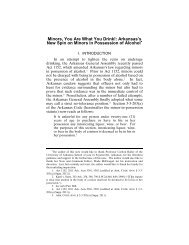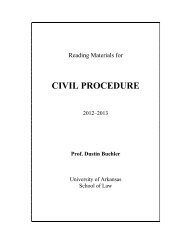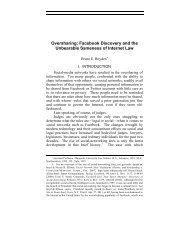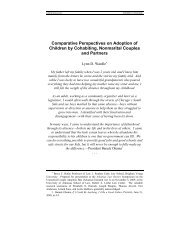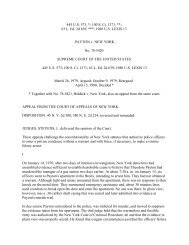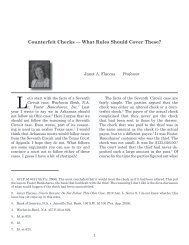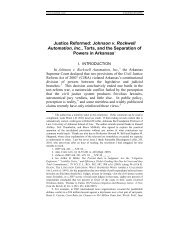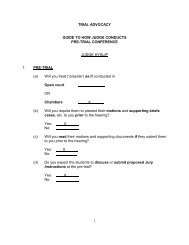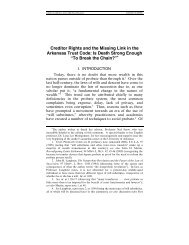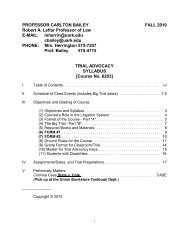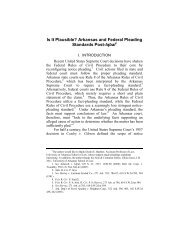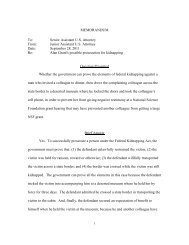Recent Developments - Arkansas Law Review
Recent Developments - Arkansas Law Review
Recent Developments - Arkansas Law Review
You also want an ePaper? Increase the reach of your titles
YUMPU automatically turns print PDFs into web optimized ePapers that Google loves.
(16) RECENT DEVELOPMENTS.DOC 4/23/2010 3:08:33 PM<br />
RECENT DEVELOPMENTS<br />
Civil Procedure—Filing Complaint Under the Same Docket<br />
Number as a Previously Nonsuited Complaint Is Sufficient<br />
for Purposes of the Savings Statute<br />
Tucker v. Sullivant,<br />
2010 Ark. 170, __ S.W.3d __ (April 15, 2010).<br />
The <strong>Arkansas</strong> Supreme Court held in this case that, when a<br />
plaintiff files a new complaint under the same docket number as<br />
a previous case for which the plaintiff took a voluntary nonsuit,<br />
that complaint is sufficient to trigger the protections of the<br />
<strong>Arkansas</strong> savings statute, so long as the plaintiff accomplished<br />
service of process on the new complaint. Here, the plaintiffs<br />
had taken a voluntary nonsuit on a prior complaint, filed a new<br />
complaint under the same docket number within one year but<br />
after the expiration of the statute of limitations, and<br />
accomplished service on the defendant of the new complaint.<br />
As a result, the <strong>Arkansas</strong> Supreme Court held that the plaintiffs<br />
had satisfied the <strong>Arkansas</strong> savings statute.<br />
This case involved the beneficiaries of the Maurine M.<br />
Sullivant Trust: Paul and Andrew Tucker, the plaintiffs in the<br />
case; their mother, who was not a party to the case; and their<br />
aunt, Rosemary Sullivant, who was the trustee of the trust and<br />
the defendant in the case. In April 2003, Sullivant decided to<br />
dissolve the trust and liquidate its remaining assets. On<br />
February 20, 2004, the Tuckers filed a complaint seeking an<br />
accounting of the trust assets. On April 16, 2008, they took a<br />
voluntary nonsuit on that claim.<br />
On March 31, 2009, the Tuckers filed an “Amended<br />
Complaint for Accounting by Trustee” under the same docket<br />
number as their original complaint and completed timely service<br />
on the new complaint. Sullivant filed a motion to dismiss based<br />
on the applicable statute of limitations, which was five years,<br />
arguing that the new complaint did not qualify as a new action
(16) RECENT DEVELOPMENTS.DOC 4/23/2010 3:08:33 PM<br />
450 ARKANSAS LAW REVIEW [Vol. 63:449<br />
for purposes of the savings statute. On June 9, 2009, the trial<br />
court granted this motion. It subsequently denied the Tuckers’<br />
motion for reconsideration, and the Tuckers appealed.<br />
On appeal, the primary issue facing the <strong>Arkansas</strong> Supreme<br />
Court was whether the Tuckers, by filing their second complaint<br />
and completing service for that complaint, had successfully<br />
commenced a “new action” for purposes of the savings statute.<br />
The court began by examining the language of the <strong>Arkansas</strong><br />
savings statute, which provides:<br />
If any action is commenced within the time respectively<br />
prescribed in this act, in §§ 16-116-101 – 16-116-107, in §§<br />
16-114-201 – 16-114-209, or in any other act, and the<br />
plaintiff therein suffers a nonsuit, or after a verdict for him<br />
or her the judgment is arrested, or after judgment for him or<br />
her the judgment is reversed on appeal or writ of error, the<br />
plaintiff may commence a new action within one (1) year<br />
after the nonsuit suffered or judgment arrested or reversed.<br />
(quoting Ark. Code Ann. 16-56-126(a)(1) (Repl. 2005)).<br />
Overall, the court noted, the savings statute is to receive a<br />
“liberal and equitable construction” to give parties a reasonable<br />
amount of time to renew their cause of action. (citing Rettig v.<br />
Ballard, 2009 Ark. 629, at 4, __ S.W.3d __, __). As a result, in<br />
prior opinions, the court had held that, to “commence a new<br />
action” and take advantage of the savings statute, the plaintiff<br />
need only file a complaint and complete timely service on a<br />
defendant, even if that service is later invalidated. (citing id.at 4,<br />
__ S.W.3d at __).<br />
On appeal, both the plaintiffs and defendant cited cases<br />
from the <strong>Arkansas</strong> Court of Appeals in support of their<br />
respective positions. (citing Tech. Parts., Inc. v. Regions Bank,<br />
97 Ark. App. 229, 245 S.W.3d 687 (2006); Hill-Rom, Inc. v.<br />
Swink, 65 Ark. App. 71, 984 S.W.2d 834 (1999)). In<br />
Technology Partners, which Sullivant cited, a plaintiff took a<br />
voluntary nonsuit and, nearly one year later, attempted to file an<br />
amended complaint under the old docket number, naming a new<br />
defendant. (citing Tech. Parts., 97 Ark. App. at 238, 245 S.W.3d<br />
at 695). When the trial court dismissed the amended complaint<br />
due to the prior dismissal of the claim, the plaintiff filed a new<br />
complaint more than a year after the original voluntary nonsuit.<br />
(citing id.). The <strong>Arkansas</strong> Court of Appeals held that the
(16) RECENT DEVELOPMENTS.DOC 4/23/2010 3:08:33 PM<br />
2010] RECENT DEVELOPMENTS 451<br />
plaintiff had not commenced a new action within the one-year<br />
period of the savings statute.<br />
On the other hand, in Hill-Rom, which the Tuckers cited, a<br />
plaintiff had a cause of action dismissed against one defendant<br />
and subsequently filed an “amended complaint” under the same<br />
docket number against a new defendant and stating a new cause<br />
of action. (citing Hill-Rom, 65 Ark. App. at 74, 984 S.W.2d at<br />
836). The new defendant argued for dismissal on the grounds<br />
that, due to the dismissal of the original complaint, the trial court<br />
lacked jurisdiction to accept an amended complaint. (citing id.)<br />
The court of appeals rejected this argument and held that, given<br />
the need to construe pleadings liberally, the amended complaint<br />
had to be construed as a new cause of action, even though it was<br />
filed under the old docket number. (citing id.)<br />
The <strong>Arkansas</strong> Supreme Court distinguished Technology<br />
Partners because, in that case, the new defendant had never<br />
been brought into a lawsuit within the applicable statute of<br />
limitations, and, as a result, the plaintiff could not have availed<br />
itself of the savings statute as to that defendant. (citing Tech.<br />
Parts., 97 Ark. App. at 238, 245 S.W.3d at 695). On the other<br />
hand, in this case, the Tuckers had timely made Sullivant a<br />
defendant in the original, nonsuited cause of action. As to Hill-<br />
Rom, while that case was not directly on point in that it did not<br />
involve the savings statute, the court was persuaded by its<br />
reasoning. First, it agreed that pleadings are to be liberally<br />
construed. (citing Ark. R. Civ. P. 8(f)). Second, it agreed that the<br />
assignment of an old docket number should not negate a new<br />
complaint that states a new cause of action. Further, the court<br />
held that this interpretation was consistent with the purpose of<br />
the savings statute, which is to protect plaintiffs who timely file<br />
in good faith from suffering “a complete loss of relief on the<br />
merits because of a procedural defect.” (quoting Rettig v.<br />
Ballard, 2009 Ark. 629, at 3-4, __ S.W.3d __, __).<br />
In this case, the Tuckers filed their second complaint and<br />
completed service on Sullivant within the one-year period of the<br />
savings statute, and, accordingly, the <strong>Arkansas</strong> Supreme Court<br />
held that they had met the requirements of that statute. To hold<br />
otherwise, the court declared, would be “exalting form over<br />
substance and violating the stated purpose of the savings<br />
statute.” As a result, the court reversed and remanded the
(16) RECENT DEVELOPMENTS.DOC 4/23/2010 3:08:33 PM<br />
452 ARKANSAS LAW REVIEW [Vol. 63:449<br />
decision of the trial court.<br />
Chief Justice Hannah and Justices Danielson and Wills<br />
dissented, with Chief Justice Hannah and Justice Wills both<br />
writing opinions in which all three dissenters joined. Chief<br />
Justice Hannah wrote to note that when the Tuckers took a<br />
voluntary nonsuit, that cause of action was terminated (citing<br />
Austin v. Austin, 241 Ark. 634, 638, 409 S.W.2d 833, 835-36<br />
(1966)). As a result the Tucker’s amended complaint was a<br />
“nullity.” Chief Justice Hannah disagreed with the majority’s<br />
decision to “ignore” this “procedural bar” and worried about<br />
what the majority’s decision might mean for the finality of<br />
judgments.<br />
Justice Wills wrote to declare that prior precedent required<br />
them to affirm the trial court. (citing West v. Searle & Co., 305<br />
Ark. 33, 36-37, 806 S.W.2d 608, 610-11 (1991). She also wrote<br />
to state her opinion that the Hill-Rom case, upon which the<br />
majority relied, was “outside the parameters of our existing case<br />
law.” (citing Hill-Rom, 65 Ark. App. at 74, 984 S.W.2d at 836)).<br />
Ultimately, Justice Wills believed that the majority had stretched<br />
the doctrine of liberal interpretation of pleadings too far in this<br />
case.
(16) RECENT DEVELOPMENTS.DOC 4/23/2010 3:08:33 PM<br />
2010] RECENT DEVELOPMENTS 453<br />
Civil Procedure—Standing Is Not a Matter of Subject<br />
Matter Jurisdiction and Cannot Be Grounds for a Writ of<br />
Prohibition<br />
Chubb Lloyds Insurance Co. v. Miller County Circuit<br />
Court,<br />
2010 Ark. 119, __ S.W.3d __ (March 11, 2010).<br />
Foremost Insurance Co. v. Miller County Circuit Court,<br />
2010 Ark. 116, __ S.W.3d __ (March 11, 2010).<br />
In these companion cases, the <strong>Arkansas</strong> Supreme Court<br />
held that standing, or lack thereof, is not a jurisdictional issue<br />
and is not, therefore, an appropriate grounds for a writ of<br />
prohibition.T 1 These cases arose from the attempts of two<br />
insurance cases to use writs of prohibition to have a proposed<br />
class-action suit dismissed prior to the trial court’s decision on<br />
class certification. Because the court held that standing was<br />
only a defense, and not a matter of jurisdiction, it deemed the<br />
writ of prohibition inappropriate in these cases.<br />
On September 8, 2004, several plaintiffs filed suit on behalf<br />
of a proposed nationwide class against several insurance<br />
companies, including Foremost Insurance Company and Chubb<br />
Lloyds Insurance Company, alleging a variety of wrongs,<br />
including conspiracy and fraud. As to both Foremost and Chubb<br />
Lloyds, the only named plaintiffs who were or ever had been<br />
their customers were dismissed from the lawsuit. In the case of<br />
Foremost, the only plaintiff with whom it had a contractual<br />
relationship was Daniel Sherrouse. Sherrouse was removed to<br />
the United Stated Bankruptcy Court for the Western District of<br />
<strong>Arkansas</strong> and then dismissed following his death. No plaintiff<br />
was substituted for Sherrouse. In the case of Chubb, the only<br />
named plaintiff who had a policy with it took a voluntary<br />
1. The court’s primary opinion on the issue of standing was Chubb Lloyds Insurance<br />
Co. v. Miller County Circuit Court, 2010 Ark. 119, __ S.W.3d __. While the discussion<br />
here of the factual background of these cases is drawn from both opinions, the discussion<br />
of the legal issues raised in these opinions is drawn entirely from the Chubb Lloyds<br />
opinion, unless otherwise noted.
(16) RECENT DEVELOPMENTS.DOC 4/23/2010 3:08:33 PM<br />
454 ARKANSAS LAW REVIEW [Vol. 63:449<br />
dismissal.<br />
As a result, both insurance companies filed motions to<br />
dismiss based on Rule 12(b)(1) of the <strong>Arkansas</strong> Rules of Civil<br />
Procedure, arguing that the court lacked subject-matter<br />
jurisdiction. In essence, the insurance companies argued that<br />
because no remaining plaintiff had standing to sue them, the<br />
court lacked jurisdiction over them. The circuit court<br />
determined that standing was a defense, not a jurisdictional<br />
issue, and that addressing the insurance companies’ standing<br />
arguments would require it to delve into the merits of the case<br />
prior to determining class certification. Accordingly, it deferred<br />
its decision on these motions until after it had made its classcertification<br />
determination.<br />
The insurance companies then filed requests for a writ of<br />
prohibition or certiorari with the <strong>Arkansas</strong> Supreme Court,<br />
asking it to stop the circuit court from exercising jurisdiction<br />
over them. The insurance companies argued that amendment 80<br />
had made standing a part of subject-matter jurisdiction in<br />
<strong>Arkansas</strong>. (citing Ark. Const. amend. 80 § 6(a)). That<br />
amendment provides in part, “Circuit courts are established as<br />
the trial courts of all justiciable matters not otherwise assigned<br />
pursuant to this Constitution.” (citing Ark. Const. amend. 80 §<br />
6(a)). The insurance companies argued that because amendment<br />
80 made justiciability an element of subject-matter jurisdiction<br />
in <strong>Arkansas</strong>, and standing is an element of justiciability,<br />
standing is part of the requirements for subject-matter<br />
jurisdiction. Because none of the remaining plaintiffs were<br />
current or former customers of the insurance companies, they<br />
argued that no remaining plaintiff had standing to sue them.<br />
Further, they argued that the conspiracy charges were not<br />
sufficient to confer standing on the remaining plaintiffs. As a<br />
result, the insurance companies argued that the lower court was<br />
without jurisdiction, and either a writ of prohibition or certiorari<br />
would be appropriate remedies in this case.<br />
The <strong>Arkansas</strong> Supreme Court began by noting that a writ of<br />
prohibition is only appropriate when a court “wholly lacks<br />
jurisdiction,” meaning that it lacks the power to “hear and<br />
determine the controversy between the parties.” (citing Ulmer v.<br />
Circuit Court of Polk County, 366 Ark. 212, 215-16, 234<br />
S.W.3d 290, 293-94 (2006)). Further, such writs are only
(16) RECENT DEVELOPMENTS.DOC 4/23/2010 3:08:33 PM<br />
2010] RECENT DEVELOPMENTS 455<br />
available when no other remedy, like an appeal, is available and<br />
will not be issued to stop a court from the erroneous exercise of<br />
its jurisdiction. (citing id.). The <strong>Arkansas</strong> Supreme Court will<br />
ultimately only issue writs of prohibition in cases of “extreme<br />
necessity.” (citing id.).<br />
Thus, to determine whether to issue writs of prohibition in<br />
these cases, the <strong>Arkansas</strong> Supreme Court had to determine<br />
whether standing was a matter of subject matter jurisdiction in<br />
<strong>Arkansas</strong>. Historically, the answer to that question had been<br />
“no.” The court thus began by citing several pre-amendment 80<br />
cases where it had refused to recognize standing as a matter of<br />
subject-matter jurisdiction. (citing Ark. Game & Fish Comm’n v.<br />
Murders, 327 Ark. 426, 428, 938 S.W.2d 854, 855, n.1 (1997)<br />
(“[L]ack of standing does not deprive a court of jurisdiction.”);<br />
Pulaski County v. Carriage Creek Prop. Owners Improvement<br />
Dist, No. 639, 319 Ark. 12, 14, 888 S.W.2d 652, 653 (1994)<br />
(“[W]e are unaware of any authority in this Court holding that<br />
lack of standing deprives a court of jurisdiction.”); Nat’l Sec.<br />
Fire & Cas. Co. v. Poskey, 309 Ark. 206, 207, 828 S.W.2d 836,<br />
837-38 (1992) (“The propriety of hearing such a case, especially<br />
when it appears that no cause of action exists . . . is a distinctly<br />
different issue and one that is not addressed in a writ of<br />
prohibition.”)).<br />
The insurance companies argued, however, that amendment<br />
80 had changed the law in <strong>Arkansas</strong> by making justiciability,<br />
and concomitantly standing, a matter of subject-matter<br />
jurisdiction. The <strong>Arkansas</strong> Supreme Court disagreed, noting<br />
that its post-amendment 80 jurisprudence had not reflected this<br />
supposed shift in the law. (citing Ulmer, 366 Ark. at 216-17, 234<br />
S.W.3d at 294) (refusing to grant a writ of prohibition based on<br />
lack of standing); Populist Party of Ark. v. Chesterfield, 359<br />
Ark. 58, 63, 195 S.W.3d 354, 357 (2004) (refusing to hear a<br />
standing argument on appeal without proper objection below)).<br />
As a result, the court refused to accept the insurance companies’<br />
interpretation of the law.<br />
The court also distinguished and/or dismissed as dicta two<br />
cases that the insurance companies cited as supporting their<br />
position. (citing Giles v. Harrington, Miller, Neihouse & Krug,<br />
362 Ark. 338, 208 S.W.3d 197 (2005); Hames v. Cravens, 332<br />
Ark. 437, 966 S.W.2d 244 (1998)). In the Giles case, the court
(16) RECENT DEVELOPMENTS.DOC 4/23/2010 3:08:33 PM<br />
456 ARKANSAS LAW REVIEW [Vol. 63:449<br />
had actually stated, “The [plaintiffs] are without standing to<br />
bring suit, and the trial court was without jurisdiction to hear the<br />
case.” (citing Giles, 362 Ark. at 348-49, 208 S.W.3d at 204).<br />
The court in this case, however, dismissed that statement as<br />
being only dicta because it was not reflected in the disposition of<br />
the case. As to the Hames case, the court distinguished it as<br />
being dismissed for being filed in the wrong court, not for lack<br />
of standing. (citing Hames, 332 Ark. at 441, 966 S.W.2d at 246).<br />
Finally, the insurance companies argued that <strong>Arkansas</strong><br />
should follow federal precedent, which does make standing an<br />
element of subject-matter jurisdiction. The <strong>Arkansas</strong> Supreme<br />
Court acknowledged that, in the federal courts, jurisdiction is<br />
limited to actual “cases” or “controversies,” and standing is one<br />
doctrine that in part defines the limits of a “case or controversy.”<br />
(citing Clinton v. City of New York, 524 U.S. 417, 429-30<br />
(1998); Warth v. Seldin, 422 U.S. 490, 498-99 (1975); Ben<br />
Oehrleins & Sons & Daughter, Inc. v. Hennepin County, 115<br />
F.3d 1372, 1373 (8th Cir. 1997); Neighborhood Transp. Net.,<br />
Inc. v. Pena, 42 F.3d 1169, 1172 (8th Cir. 1994). Some states<br />
likewise require standing as an element of jurisdiction. (citing<br />
Tex. Ass’n of Bus. v. Tex. Air Control Bd., 852 S.W.2d 440, 444-<br />
45 (Tex. 1993)). <strong>Arkansas</strong>, however, has not followed and is<br />
not compelled to follow the precedents set by these other<br />
jurisdictions. (citing David Newbern & John Watkins, 2<br />
<strong>Arkansas</strong> Civil Practice and Procedure 155 (4th ed. 2006)).<br />
Ultimately, the court rejected the insurance companies’<br />
argument that amendment 80 had changed <strong>Arkansas</strong> law based<br />
on its case law and the text of amendment 80 itself. As to its<br />
case law, the <strong>Arkansas</strong> Supreme Court had previously held,<br />
“Amendment 80 did not alter the jurisdiction of law and equity.<br />
It only consolidated jurisdiction in the circuit courts.” (quoting<br />
First Nat’l Bank of DeWitt v. Cruthis, 360 Ark. 528, 534, 203<br />
S.W.3d 88, 92 (2005)). Further the text of amendment 80<br />
provides, “Jurisdiction conferred on Circuit Courts established<br />
by this Amendment includes all matters previously cognizable<br />
by Circuit, Chancery, Probate, and Juvenile Courts.” (citing Ark.<br />
Const. amend. 80, § 19(b)(1)). Therefore, the court refused to<br />
hold that standing was a matter of subject-matter jurisdiction,<br />
and, as a result, a writ of prohibition was not an appropriate<br />
remedy in the case.
(16) RECENT DEVELOPMENTS.DOC 4/23/2010 3:08:33 PM<br />
2010] RECENT DEVELOPMENTS 457<br />
As to the alternative remedy of a writ of certiorari, the court<br />
rejected that request on similar grounds. Because standing is not<br />
a matter of jurisdiction in <strong>Arkansas</strong>, the court held that none of<br />
the applicable grounds for granting a writ of certiorari applied in<br />
this case. (citing Conner v. Simes, 355 Ark. 432, 438, 139<br />
S.W.3d 476, 479-80 (2003)). As a result, the court also rejected<br />
the insurance companies’ alternative request.<br />
Foremost also had two arguments on appeal that were<br />
unique to it. 2 First, Foremost argued that the lack of jurisdiction<br />
in this case was apparent on the face of the record, meaning that<br />
the trial court had no need to defer its decision on Foremost’s<br />
motions to dismiss to avoid delving into the merits of the case<br />
before certifying the class. The <strong>Arkansas</strong> Supreme Court<br />
rejected this argument noting first that it had only permitted, and<br />
not required, the granting of some motions to dismiss prior to<br />
class certification. (citing Speights v. Stewart Title Guar. Co.,<br />
358 Ark. 59, 65-A, 186 S.W.3d 715, 715 (2004) (supplemental<br />
opinion on denial of rehearing)). Further, the court had already<br />
rejected Foremost’s jurisdictional arguments and so did not<br />
agree that any jurisdictional defects were apparent on the face of<br />
the record.<br />
For its second additional argument, Foremost argued that<br />
the trial court’s refusal to determine its “power to act” prior to<br />
certification deprived Foremost of due process in violation of<br />
the <strong>Arkansas</strong> and United States Constitutions. Foremost,<br />
however, cited only “authority for general due-process law,”<br />
without any cases directly on point. As a result, the <strong>Arkansas</strong><br />
Supreme Court held that it had no need to address this issue.<br />
2. The remainder of this discussion is based entirely on Foremost Insurance Co. v.<br />
Miller County Circuit Court, 2010 Ark. 116, __ S.W.3d __.
(16) RECENT DEVELOPMENTS.DOC 4/23/2010 3:08:33 PM<br />
458 ARKANSAS LAW REVIEW [Vol. 63:449<br />
Civil Justice Reform Act of 2003—Medical Malpractice<br />
Venue Provisions Held Constitutional<br />
Clark v. Johnson Regional Medical Center,<br />
2010 Ark. 115, __ S.W.3d __ (March 11, 2010).<br />
Clark v. Johnson Regional Medical Center,<br />
2010 Ark. 114, __ S.W.3d __ (March 11, 2010).<br />
In these companion cases, the <strong>Arkansas</strong> Supreme Court<br />
upheld the medical-malpractice venue provisions of the Civil<br />
Justice Reform Act of 2003 (the CJRA) against a separation-ofpowers<br />
challenge under amendment 80 to the <strong>Arkansas</strong><br />
Constitution. 3 The plaintiff here had filed the same case in two<br />
separate counties, and each circuit court dismissed those<br />
defendants for whom venue was not proper in that county. The<br />
<strong>Arkansas</strong> Supreme Court held that the trial courts had properly<br />
applied the relevant venue statutes and that these statutory<br />
provisions were constitutional. Accordingly, it affirmed the<br />
lower courts.<br />
On February 3, 2006, Mary Clark underwent back surgery<br />
at Sparks Medical Center in Sebastian County, <strong>Arkansas</strong>.<br />
Clark’s surgeon there was Dr. Arthur Johnson, and, during<br />
surgery, Clark suffered a dural tear to her left side. After being<br />
discharged, Clark continued to see Johnson at his clinic,<br />
Orthopaedics, P.A., also in Sebastian County. She was also<br />
receiving physical therapy for the surgical wound at Johnson<br />
Regional Medical Center (JRMC), in Johnson County,<br />
<strong>Arkansas</strong>. On March 8, 2006, staff at JRMC determined that<br />
Clark’s wound had become infected. Between August and<br />
December of 2006, Clark made several trips to the emergency<br />
room at JRMC, where she complained of weakness and nausea,<br />
and received treatment from three different doctors. On<br />
December 1, 2006, one of these doctors, Dr. John Dunham,<br />
3. The court’s main opinion, and the primary source of this discussion, is Clark v.<br />
Johnson Regional Medical Center, 2010 Ark. 115, __ S.W.3d __. Both cases had the same<br />
parties, and Clark raised the same arguments in both cases on appeal.
(16) RECENT DEVELOPMENTS.DOC 4/23/2010 3:08:33 PM<br />
2010] RECENT DEVELOPMENTS 459<br />
found that the surgical wound had begun to bulge and was<br />
draining. He released her with instructions to see her original<br />
surgeon within the week, but Clark returned to the JRMC<br />
emergency room the next day. Discovering that the wound was<br />
severely abscessed, Dr. Dunham had Clark transferred back to<br />
Sparks. There, doctors discovered that the infection had spread<br />
to some hardware installed in her back, necessitating the<br />
removal of that hardware.<br />
On November 26, 2007, Clark filed identical medicalmalpractice<br />
suits against each of the doctors, hospitals, and<br />
clinics that had treated her in both Johnson and Sebastian<br />
Counties. In each case, the defendants that had not treated Clark<br />
in that county made a motion to dismiss based on <strong>Arkansas</strong> Rule<br />
of Civil Procedure 12(b)(3) and section 16-55-213(e) of the<br />
<strong>Arkansas</strong> Code, the medical-malpractice venue provision of the<br />
CJRA, arguing that venue was improper in that county. Both<br />
circuit courts dismissed the claims against those defendants that<br />
did not practice in its county, i.e., the Johnson County Court<br />
dismissed the Sebastian County defendants and the Sebastian<br />
court dismissed the Johnson defendants. Clark appealed the<br />
decisions of both trial courts, producing these two opinions.<br />
On appeal, Clark raised two arguments. First, Clark argued<br />
that the courts should not have applied the CJRA’s medicalmalpractice<br />
venue provision to her claim. Second, she argued in<br />
the alternative that the venue statute was unconstitutional. The<br />
<strong>Arkansas</strong> Supreme Court rejected both arguments, affirming the<br />
trial courts.<br />
As to the application of this provision, Clark argued that<br />
the provision only applies when a medical injury occurred in a<br />
single county and involved only a single medical provider.<br />
Clark, on the other hand, had alleged that the negligence of<br />
multiple providers in multiple counties had caused her injuries.<br />
Accordingly, she argued, the provision could not apply to her<br />
claim.<br />
The <strong>Arkansas</strong> Supreme Court began by looking at the plain<br />
language of the statute. The CJRA’s venue provision provides<br />
in part:<br />
(a) All civil actions other than those mentioned in §§ 16-<br />
60-101–16-60-103, 16-60-107, 16-60-114, and 16-60-115,<br />
and subsection (e) of this section must be brought in any of
(16) RECENT DEVELOPMENTS.DOC 4/23/2010 3:08:33 PM<br />
460 ARKANSAS LAW REVIEW [Vol. 63:449<br />
the following counties:<br />
(1) The county in which a substantial part of the events or<br />
omissions giving rise to the claim occurred;<br />
(2)(A) The county in which an individual defendant<br />
resided.<br />
(B) If the defendant is an entity other than an individual,<br />
the county where the entity had its principal office in this<br />
state at the time of the accrual of the cause of action; or<br />
(3)(A) The county in which the plaintiff resided.<br />
(B) If the plaintiff is an entity other than an individual, the<br />
county where the plaintiff had its principal office in this<br />
state at the time of the accrual of the cause of action. . . .<br />
(e) Any action for medical injury brought under § 16-114-<br />
201 et seq. against a medical care provider, as defined in §<br />
16-114-201(2), shall be filed in the county in which the<br />
alleged act or omission occurred.<br />
(quoting Ark. Code Ann. § 16-55-213(a), (e) (Repl. 2005)). In<br />
looking at the statute’s plain language, the court simply noted<br />
that it found nothing to support Clark’s proposed limitation.<br />
The Court found further support for rejecting Clark’s<br />
proposed interpretation in the interpretations it had already given<br />
to the Medical Malpractice Act. (citing Ark. Code Ann. § 16-<br />
114-201(1) (Repl. 2006)). Clark wanted the court to interpret<br />
the singular nouns in section 16-55-213(e) literally, meaning, for<br />
example, that 213(e) would only apply to cases involving “a”<br />
medical provider. The court, however, had already interpreted<br />
similar language in the Medical Malpractice Act to apply to<br />
cases with multiple defendants. (citing Rice v. Tanner, 363 Ark.<br />
79, 81, 210 S.W.3d 860, 862 (2005); Adams v. Arthur, 333 Ark.<br />
53, 61-62, 969 S.W.2d 598, 602 (1998)). The court also rejected<br />
Clark’s claim that its reading of the CJRA’s venue provision<br />
failed to harmonize subsections (a) and (e), and, as a result, it<br />
rejected Clark’s proposed interpretation as creating absurd<br />
results.<br />
The court next turned to Clark’s constitutional arguments.<br />
Clark argued that the provision in question violated the<br />
separation-of-powers provision of the <strong>Arkansas</strong> Constitution by<br />
being a legislative encroachment on the judiciary’s power to set
(16) RECENT DEVELOPMENTS.DOC 4/23/2010 3:08:33 PM<br />
2010] RECENT DEVELOPMENTS 461<br />
the rules of pleading, practice, and procedure. (citing Ark.<br />
Const. art. 4, § 2; amend. 80, § 3). Clark cited previous cases<br />
where the <strong>Arkansas</strong> Supreme Court had struck down parts of the<br />
CJRA as impinging upon its power over procedure for the<br />
proposition that a statute conflicting with the <strong>Arkansas</strong> Rules of<br />
Civil Procedure is invalid. (citing Johnson v. Rockwell<br />
Automation, Inc., 2009 Ark. 241, at 7, __ S.W.3d __, __;<br />
Summerville v. Thrower, 369 Ark. 231, 239, 253 S.W.3d 415,<br />
421 (2007)). Clark then noted that CJRA’s medical-malpractice<br />
venue provision conflicts with these rules in that it would<br />
prohibit joinder of all defendants under Rule 20, prevent the<br />
joinder of necessary parties under Rule 19, and prevent some<br />
necessary counter- and cross-claims from being brought under<br />
Rule 13.<br />
While the court noted this prior precedent and the potential<br />
conflicts between the statute and its rules, it rejected Clark’s<br />
arguments because setting venue is within the province of the<br />
legislature. First, the court noted that amendment 80 gives the<br />
General Assembly the power to set venue. (citing Ark. Const.<br />
amend. 80, § 10). Second, the court looked to its precedents,<br />
which had previously established the legislature’s power over<br />
venue. (citing Farm Bur. Mut. Ins. Co. of Ark. v. Gadbury-Swift,<br />
2010 Ark. 6, at 8, __ S.W.3d __, __; Dotson v. City of Lowell,<br />
375 Ark. 89, 92, 289 S.W.3d 55, 58 (2008)). Finally, the court<br />
noted that the <strong>Arkansas</strong> Rules of Civil Procedure themselves<br />
state that they “shall not be construed to extend or limit...the<br />
venue of” the circuit courts. (quoting Ark. R. Civ. P. 82). As a<br />
result, the court distinguished this statute from other parts of the<br />
CJRA that it had stricken, upholding the constitutionality of the<br />
CJRA’s medical-malpractice venue provision.<br />
Justices Danielson and Wills wrote concurring opinions.<br />
Justice Danielson suggested that the legislature reconsider this<br />
provision in light of the potential procedural problems it may<br />
cause and questioned the constitutionality of this provision on<br />
other grounds, namely the fact that it “carved out” a venue<br />
provision for a single industry. Justice Wills wrote to say that<br />
she would have confined the majority’s analysis entirely to the<br />
text of the <strong>Arkansas</strong> Constitution, without referring to<br />
extraneous sources such as Rule 82 of the <strong>Arkansas</strong> Rules of<br />
Civil Procedure.
(16) RECENT DEVELOPMENTS.DOC 4/23/2010 3:08:33 PM<br />
462 ARKANSAS LAW REVIEW [Vol. 63:449<br />
Insurance <strong>Law</strong>—Insurance Company May Not Need to<br />
Show Prejudice to Avoid Coverage Based on an Insured’s<br />
Failure to Provide Timely Notice of a Claim<br />
Fireman’s Fund Insurance Co. v. Care Management,<br />
Inc.,<br />
2010 Ark. 110, __ S.W.3d __ (March 4, 2010).<br />
In this case, the <strong>Arkansas</strong> Supreme Court held that, where<br />
timely notice of a claim is a condition precedent to insurance<br />
coverage, the insurance company is not required to prove<br />
prejudice in order to avoid coverage. This case arose as a<br />
certified question from Judge Leon Holmes, United States<br />
District Judge for the Eastern District of <strong>Arkansas</strong>, as to whether<br />
such a showing of prejudice was necessary under <strong>Arkansas</strong> law.<br />
The <strong>Arkansas</strong> Supreme Court answered that question in the<br />
negative, provided that timely notice was a condition precedent<br />
to coverage.<br />
In 2000, Southwest Nursing Home, Inc., took out a<br />
healthcare facility liability insurance policy with Fireman’s<br />
Fund Insurance Co. A subsequent endorsement changed the<br />
named insured to Care Management, Inc. D/B/A Southwest<br />
Nursing Homes, and Fireman’s Fund transferred its obligations<br />
under the policy to Healthcare Underwriters Mutual, which later<br />
changed its name to Medical Liability Mutual Insurance<br />
Company (MLMIC). Thus, by July 2001, the named parties to<br />
this insurance policy were Care Management, the named<br />
insured, and MLMIC.<br />
On June 15, 2006, Carole Henson brought a wrongful-death<br />
claim against Care Management and other defendants on behalf<br />
of the estate of Mamie Denton. On September 26, 2008, Care<br />
Management’s attorney wrote a letter to MLMIC to inquire<br />
about insurance coverage. At the time, the case was scheduled<br />
for a final hearing on October 7, 2008, and this letter was the<br />
first notice to MLMIC from Care Management as to the claim<br />
against it.<br />
In October 2008, Care Management’s attorney sent two<br />
more requests to MLMIC for coverage under its policy with<br />
MLMIC. Finally, Care Management filed a declaratory-
(16) RECENT DEVELOPMENTS.DOC 4/23/2010 3:08:33 PM<br />
2010] RECENT DEVELOPMENTS 463<br />
judgment action in the United States District Court for the<br />
Eastern District of <strong>Arkansas</strong>. In a motion for summary<br />
judgment, MLMIC cited language in the policy that it claimed<br />
created a condition precedent to coverage. This policy listed, as<br />
one of Care Management’s “Duties in Event of Claim,” to<br />
“[n]otify [MLMIC] in writing as soon as practicable” after a<br />
claim was made against it. Further, the policy provided that no<br />
one could sue MLMIC unless all of the terms of the policy had<br />
been “fully complied with.” Because two years had elapsed<br />
from the filing of the complaint against Care Management and<br />
its providing notice to MLMIC, MLMIC claimed that this<br />
condition precedent had not been fulfilled, and as a result, its<br />
coverage obligation had not arisen. On the day after MLMIC<br />
filed its motion for summary judgment, November 25, 2008, the<br />
Denton estate moved for and obtained a voluntary dismissal<br />
without prejudice of the underlying state-court action against<br />
Care Management.<br />
The district court noted that the Eighth Circuit had<br />
previously held that, under <strong>Arkansas</strong> law, the insurance<br />
company had no need to show prejudice to avoid liability when<br />
notification was a condition precedent to coverage. The Eighth<br />
Circuit, however, had recently expressed doubt as to the validity<br />
of that prior holding. (citing AIG Centennial Ins. Co. v. Fraley-<br />
Landers, 450 F.3d 761, 767 (8th Cir. 2006)). As a result, the<br />
district court certified the following question to the <strong>Arkansas</strong><br />
Supreme Court:<br />
When an insurance policy requires the insured to give<br />
notice of a claim as soon as practicable and the insured fails<br />
to give the insurer notice of the claim as soon as<br />
practicable, must the insurer prove that it was prejudiced by<br />
the failure to give timely notice in order to avoid coverage?<br />
The <strong>Arkansas</strong> Supreme Court accepted the certified question,<br />
adding the phrase “is a condition precedent to recovery” after<br />
the first occurrence of the phrase “as soon as practicable,” and<br />
answered the question as modified in the negative.<br />
The answer to this question turned on the distinction<br />
between a requirement of notice that is a condition precedent to<br />
coverage and one that is an ordinary contract promise. When<br />
the policy requires notice as a condition precedent to coverage,<br />
the insured must strictly comply with that requirement. As a
(16) RECENT DEVELOPMENTS.DOC 4/23/2010 3:08:33 PM<br />
464 ARKANSAS LAW REVIEW [Vol. 63:449<br />
result, the insurer need not show prejudice to avoid liability on<br />
the policy. On the other hand, when the requirement of notice is<br />
an ordinary contract promise, the insured’s noncompliance does<br />
not forfeit coverage under the policy unless the insurance<br />
company can demonstrate that it was prejudiced by the delay or<br />
lack of notice. The court noted, however, that an unreasonable<br />
delay in notice could in itself be prejudicial to the insurer. In<br />
reaching this conclusion, the court explicitly acknowledged that<br />
it was bucking the current trend toward requiring a showing of<br />
prejudice more frequently but felt compelled to reach its holding<br />
because “[i]n <strong>Arkansas</strong>, a condition precedent is still a condition<br />
precedent.” (citing Alcazar v. Hayes, 982 S.W.2d 845 (Tenn.<br />
1998)).<br />
To reach its conclusion in this case, the court turned to its<br />
prior precedent on the subject. From its first case addressing the<br />
issue, the <strong>Arkansas</strong> Supreme Court had not required the insurer<br />
to show prejudice when notice of a claim was a condition<br />
precedent to recovery. (citing Teutonia Ins. Co. v. Johnson, 72<br />
Ark. 484, 490, 82 S.W. 840, 842 (1903)). The court had not<br />
changed its position in subsequent cases. (citing Myers v. Mut.<br />
of Omaha Ins. Co., 253 Ark. 135, 136, 484 S.W.2d 879, 880<br />
(1972); Am. Fid. & Cas. Co. v. Ne. Ark. Bus Lines, Inc., 201<br />
Ark. 622, 623, 146 S.W.2d 165, 166 (1941); Pac. Mut. Life Ins.<br />
Co. v. Butler, 190 Ark. 282, 286, 78 S.W.2d 813, 815 (1935)).<br />
Further, the court had likewise required strict compliance from<br />
the insured when provisions other than notice were a condition<br />
precedent to coverage. (citing Vill. Mkt., Inc. v. State Farm Gen.<br />
Ins. Co., 333 Ark. 552, 557, 970 S.W.2d 243, 247 (1998)). On<br />
the other hand, the court had required a showing of prejudice on<br />
the part of the insurer when notice was not a condition precedent<br />
to coverage. (citing Home Indem. Co. v. Banfield Bros. Packing<br />
Co., 188 Ark. 683, 689, 67 S.W.2d 203, 206 (1934); Home Life<br />
& Acc. Co. v. Beckner, 168 Ark. 283, 288, 270 S.W. 529, 531<br />
(1925); Hope Spoke Co. v. Md. Cas. Co., 102 Ark. 1, 8, 143<br />
S.W. 85, 87 (1912)). As a result, the court held that whether the<br />
insurer must show prejudice turns on whether the clause in<br />
question was a condition precedent.<br />
The court acknowledged that the confusion in the Eighth<br />
Circuit over <strong>Arkansas</strong> law on this point arose from three cases,<br />
each of which had imposed liability when an insurer had failed
(16) RECENT DEVELOPMENTS.DOC 4/23/2010 3:08:33 PM<br />
2010] RECENT DEVELOPMENTS 465<br />
to show it was prejudiced by the insured’s failure to comply<br />
strictly with a notice requirement in the policy. (citing Members<br />
Mut. Ins. Co. v. Benefield, 255 Ark. 156, 158, 499 S.W.2d 608,<br />
609 (1973); Kealy v. Lumberman’s Mut. Ins. Co., 239 Ark. 766,<br />
767, 394 S.W.2d 629, 630 (1965); So. Farm Bur. Cas. Ins. Co v.<br />
Robinson, 236 Ark. 268, 274, 364 S.W.2d 454, 458 (1963)). As<br />
to two of these cases, the court held that they were in fact<br />
consistent with its current holding because the provisions in<br />
question in those cases did not make notice a condition<br />
precedent to coverage. (citing Kealy, 239 Ark. at 767, 294<br />
S.W.2d at 630; Robinson, 236 Ark. at 274, 364 S.W.2d at 458).<br />
On the other hand, the court could not reconcile the third case<br />
with its holding and, accordingly, overruled it. (citing Benefield,<br />
255 Ark. at 158, 499 S.W.2d at 609).<br />
Finally, the court turned to a case that it ultimately deemed<br />
to be irrelevant to the certified question before it. (citing M.F.A.<br />
Mut. Ins. Co. v. White, 232 Ark. 28, 334 S.W.2d 686 (1960)). In<br />
that case, like this one, the plaintiff in the underlying claim<br />
giving rise to the dispute over insurance coverage had<br />
voluntarily dismissed that claim. (citing id. at 29, 334 S.W.2d at<br />
687). The White court held that the insured’s failure to comply<br />
with a notice condition as to the voluntarily dismissed suit did<br />
not give the insurance company a defense to coverage in a<br />
subsequent suit based on the same facts. (citing id. at 30, 334<br />
S.W.2d at 687). While the court did not dispute that holding, it<br />
concluded it had no bearing on the certified question before it.<br />
Thus, while the dismissal of the suit does “essentially reset” the<br />
duty of the insured to provide notice of the claim against it, the<br />
insured still must strictly comply with any notice requirement as<br />
to a subsequent suit, if that notice requirement is a condition<br />
precedent to recovery. Ultimately, whether an insured must<br />
show prejudice from a failure of the insured to comply strictly<br />
with a notice requirement will depend on whether that notice<br />
requirement was a condition precedent to recovery.<br />
MICHAEL A. THOMPSON



